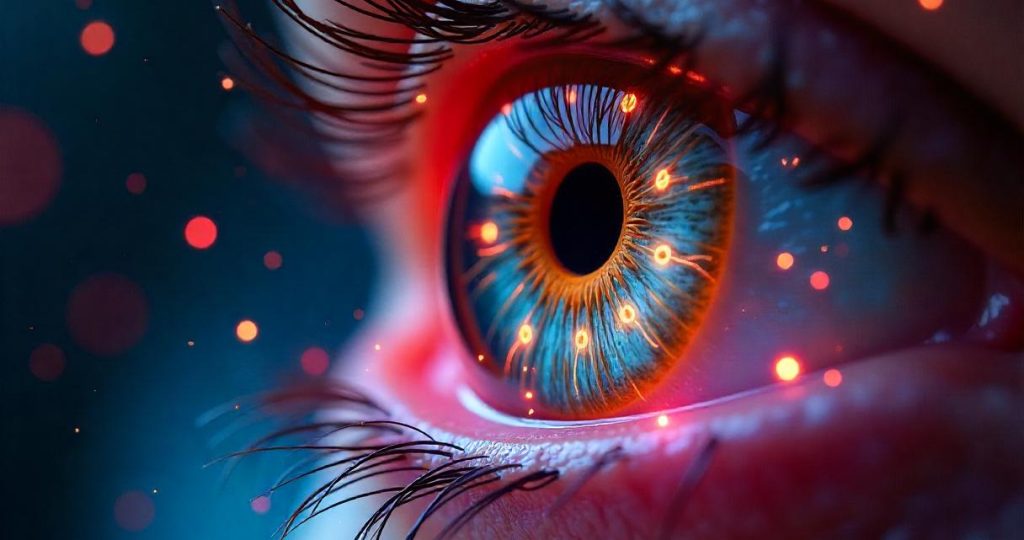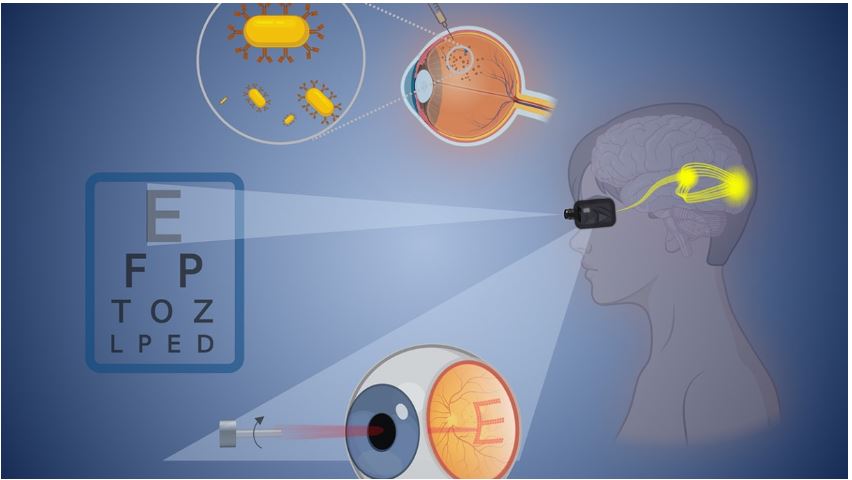Medically Reviewed By Vikas Londhe M.Pharm (Pharmacology)

Researchers at Brown University have developed a groundbreaking vision restoration method that could help people regain vision loss due to retinal diseases like age-related macular degeneration (AMD) and retinitis pigmentosa. These common causes of vision loss damage the retina the light-sensitive layer at the back of the eye leading to progressive blindness. The innovative approach involves using gold nanoparticles, tiny biocompatible particles that can be safely introduced into the eye. When stimulated by near-infrared (NIR) laser light, these nanoparticles activate the remaining retinal cells, allowing them to send visual signals to the brain much like healthy photoreceptors do. This emerging technology has the potential to outperform existing retinal prosthetics by offering a minimally invasive, less painful alternative that could deliver higher-quality vision restoration. With its promise of improved outcomes, enhanced safety, and greater accessibility, this cutting-edge technique could transform the treatment of retinal degeneration and provide hope for millions living with severe vision impairment or blindness.
The Science behind the Innovation
In healthy eyes, specialized cells called photoreceptors rods and cones detect light and convert it into electrical signals. These signals are then passed to other key retinal cells, such as bipolar cells and ganglion cells, which relay the information to the brain, allowing us to perceive images. However, in degenerative eye diseases like age-related macular degeneration (AMD) and retinitis pigmentosa, these critical photoreceptors degenerate and eventually stop functioning, leading to progressive vision loss and, in severe cases, blindness. Remarkably, the inner retinal cells like bipolar and ganglion cells often remain intact and functional even after the photoreceptors are lost. Building on this insight, researchers at Brown University are developing an innovative vision restoration approach that bypasses the damaged photoreceptors entirely. By using advanced technology to directly stimulate the surviving inner retinal cells, this method could restore vision in individuals affected by retinal degeneration. This novel strategy has the potential to revolutionize vision loss treatment by targeting still-viable parts of the eye, offering a powerful alternative to traditional therapies and retinal implants.

Image Source: Brown University from an article: Golden eyes: How gold nanoparticles may one day help to restore people’s vision. Image Showing: How gold nanoparticles work and how it will create visual image in the mind of patient
The research team at Brown University has developed a cutting-edge technique involving the use of gold nanorods ultra-small, rod-shaped particles made of gold delivered directly into the eye through a minimally invasive procedure called intravitreal injection. These gold nanorods are precisely engineered to absorb near-infrared (NIR) light, a safe and effective wavelength that penetrates deep into the eye without causing damage, since it is minimally absorbed by water in the tissue. Once exposed to NIR light, the gold nanorods undergo a process called surface plasmon resonance, which generates localized and highly controlled heat. This subtle thermal energy can activate surrounding retinal nerve cells in two key ways: by inducing tiny electric currents across their membranes or by triggering specialized ion channels that respond to changes in temperature. This innovative approach offers a promising new method for restoring vision by reactivating the surviving retinal cells in individuals affected by degenerative eye diseases such as macular degeneration and retinitis pigmentosa. It also holds the potential to be a safer, more precise alternative to traditional retinal implants or surgical treatments.
Promising Results in Preclinical Studies
In experimental tests with mice suffering from retinal damage, the research team injected gold nanoparticles into the animals’ eyes and projected patterned near-infrared (NIR) laser light onto the retina. These light patterns, shaped like simple images, were designed to test whether the NIR light could stimulate the remaining healthy retinal cells. Using a powerful technique called calcium imaging; the scientists observed that the bipolar and ganglion cells key players in the visual signalling pathway responded to the laser patterns in a manner similar to how they would react to natural light in a healthy retina. Additionally, brain imaging revealed increased activity in the visual cortex, the region of the brain responsible for processing visual information. This indicated that the brain was once again receiving visual input, a strong sign that sight could potentially be restored. Even more promising, the gold nanoparticles remained stable and safely positioned within the eye for several months, with no signs of toxicity or inflammation. These results highlight the long-term potential of this non-invasive, laser-activated nanoparticle therapy as a safe and effective treatment for restoring vision in people affected by retinal degenerative diseases.
Advantages over Traditional Retinal Prosthetics
This new nanoparticle based method has several key benefits compared to current retinal prosthetic devices. First, it is minimally invasive unlike traditional devices that require complex surgery to implant electrodes; this approach only needs a simple injection into the eye, a common and low-risk procedure in eye care. Second, it offers much higher resolution. Existing devices are limited because they can only stimulate certain fixed spots in the retina, often resulting in blurry or narrow vision. In contrast, the nanoparticles can be targeted more precisely, even down to individual cells, and their stimulation pattern can be changed as needed, potentially restoring a full, detailed field of vision. Lastly, because it uses near-infrared (NIR) light, which doesn’t affect visible light, this method can work alongside any natural vision a person still has, making it a more flexible and user-friendly solution.
Future Outlook
Researchers aim to transform this groundbreaking vision restoration technology into a wearable device, such as smart glasses or high-tech goggles equipped with a camera and a near-infrared (NIR) laser system. The camera would continuously capture visual input from the surrounding environment, while the NIR laser projects precise light patterns onto the retina. These patterns would activate specially designed gold nanoparticles, allowing the user to perceive visual images without the need for invasive procedures. Although more research is needed to confirm long-term safety and effectiveness in larger animal models and eventually in humans, this innovative approach could revolutionize treatment options for millions suffering from retinal diseases and vision loss. By eliminating the need for genetic modification or complex surgical implants, this technology offers a potentially safer, more accessible and cost-effective alternative to current retinal prosthetics, paving the way for broader adoption and improved quality of life for patients worldwide.
Reference:
1. 1.Jiarui Nie, Kyungsik Eom, Hafithe M. AlGhosain, ntravitreally Injected Plasmonic Nanorods Activate Bipolar Cells with Patterned Near-Infrared Laser Projection ACS Nano 2025, 19, 12, 11823–11840, https://doi.org/10.1021/acsnano.4c14061
2. Golden eyes: How gold nanoparticles may one day help to restore people’s vision, 16 April 2025, Brown University.
3. Chen F , Si P , de la Zerda A , Jokerst JV , Myung D . Gold nanoparticles to enhance ophthalmic imaging. Biomater Sci. 2021 Jan 21;9(2):367-390. doi: 10.1039/d0bm01063d. Epub 2020 Oct 15. PMID: 33057463; PMCID: PMC8063223.
4. Natarajan S. Retinitis pigmentosa: a brief overview. Indian J Ophthalmol. 2011 Sep-Oct; 59(5):343-6. Doi: 10.4103/0301-4738.83608. PMID: 21836337; PMCID: PMC3159313.
5. Giuliana Gagliardi, Karim Ben M’Barek, Olivier Goureau, Photoreceptor cell replacement in macular degeneration and retinitis pigmentosa: A pluripotent stem cell-based approach, Progress in Retinal and Eye Research, Volume 71, 2019, Pages 1-25, https://doi.org/10.1016/j.preteyeres.2019.03.001
6. Treating retinal disease with tiny gold particles, 24 April 2025, Association of optometrist, available from https://www.aop.org.uk/ot/news/2025/04/24/treating-retinal-disease-with-tiny-gold-particles
7. NEI-funded researchers test new visual prosthesis system to restore vision, 18 April 2025, National Eye Institute, available from https://www.nei.nih.gov/about/news-and-events/news/nei-funded-researchers-test-new-visual-prosthesis-system-restore-vision

